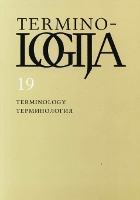Turinio sąveikumo būtinybė naudojant struktūrizuoto turinio vienetus kaip elektroninio mokymosi objektus pakartotinai ar pagal kitokią paskirtį
Content interoperability as a prerequisite for re-using and re-purposing items of structured content as learning objects in eLearning – Seen under a standardisation perspective
Author(s): Christian Galinski, Blanca Stella Giraldo PérezSubject(s): Education, Theoretical Linguistics, Lexis, Semantics, ICT Information and Communications Technologies
Published by: Lietuvių Kalbos Institutas
Keywords: structured content and unstructured content; verbal and non-verbal representations; appellations; morphology and morphemes; phraseology and phrasemes; collocations and multi-word terms;
Summary/Abstract: “Content” here is seen as structured content at the level of lexical semantics comprising linguistic and non-linguistic representations of concepts (understood in science theory as a kind of “immaterial objects”). These representations can be designative (such as designations in terminology: comprising terms, symbols and appellations) or descriptive (such as various kinds of definitions, explanations or non-verbal representations), or hybrid. So far non-verbal designations and representations of concepts as well as appellations (i.e. proper names representing individual concepts) have been underrepresented in terminology theory and methodology. But they can be very important for designing learning objects (LO) in certain domains or fields of application – not to mention for language learning and translation.
Journal: Terminologija
- Issue Year: 2012
- Issue No: 19
- Page Range: 6-32
- Page Count: 27
- Language: English

